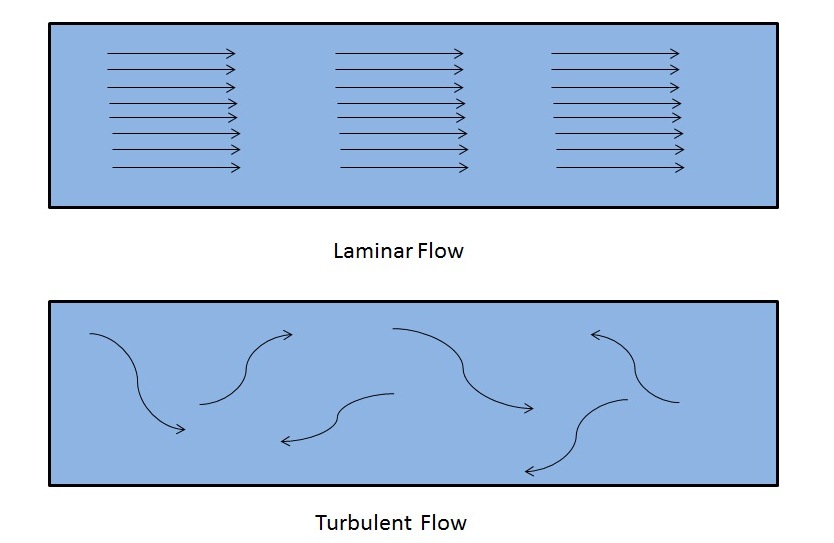Knowing about the difference between laminar and turbulent flow is very necessary, if you are going to studying the fluid mechanics. They are just the type of fluid flow. When a fluid flows either in the channel or in pipes, it may be either laminar flow or turbulent flow. In this article, we will discuss the difference between laminar and turbulent flow.
Difference Between Laminar and Turbulent Flow

|
S.no
|
Laminar Flow
|
Turbulent Flow
|
|
1.
|
It is a fluid flow in which the fluid layers move parallel to each other and do not cross each other.
|
It is a fluid flow in which the fluid layers cross each other and do not move parallel to each other.
|
|
2.
|
The laminar flow generally occurs in the fluid flowing with low velocity.
|
The turbulent flow occurs when the fluid flows with high velocity.
|
|
3.
|
Laminar flow occurs in the small diameter pipes in which fluid flows
with low velocity. |
Turbulent flow occurs in large diameter pipes in which fluid flows with high velocity.
|
|
4.
|
The fluid flow is laminar when the value of Reynolds number (Re) is less than 2000.
|
The fluid flow is turbulent when the value of Reynolds number is greater than 4000.
|
|
5.
|
Shear stress in laminar flow depends only on the viscosity of the fluid and independent of the density.
|
Shear stress in the turbulent flow depends upon the density of the fluid.
|
|
6.
|
The fluid flow is very orderly i.e. there is no mixing of adjacent layers of the fluid and they move parallel to each other and also with the walls of the pipe.
|
The fluid flow is not orderly i.e. there is mixing of adjacent layers of fluid with each other and they do not move parallel to each other and also with the walls of the pipe.
|
Summary of the Difference Between Laminar and Turbulent Flow
Laminar Flow
- The fluid flow in which the adjacent layers of the fluid do not mix with each other and moves parallel to each other is called laminar flow.
- In the laminar flow, the fluid layer moves in straight line.
- The laminar flow always occurs when the fluid flow with low velocity and in small diameter pipes.
- The fluid flow having Reynolds number less than 2000 is called laminar flow.
- The fluid flow is very orderly i.e. there is no mixing of adjacent layers of the fluid and they move parallel to each other and also with the walls of the pipe.
- Shear stress in laminar flow depends only on the viscosity of the fluid and independent of the density.
Also Read:
- What is Reaction Turbine – Principle, Working, Main Components and Application
- What is Impulse Turbine – Working Principle, Main Parts, Types and Application
- What is Kaplan Turbine and How It Works?
Turbulent Flow
- The fluid flow in which the adjacent layers of the fluid cross each other and do not move parallel to each other is called turbulent flow.
- In turbulent flow the fluid layers do not move in a straight line. They move randomly in a zigzag manner.
- The turbulent flow occurs when the velocity of the fluid is high and it flows through larger diameter pipes.
- The fluid flow having Reynolds number greater than 4000 is called turbulent flow.
- The fluid does not flow in a definite order. There is a mixing of different layers and they do not move parallel to each other but cross each other.
- The shear stress in turbulent flow depends upon its density.
For better explanation watch the video given below:
This is all about the difference between laminar and turbulent flow. And if you found this piece of information valuable and useful then don’t forget to like and share it.

